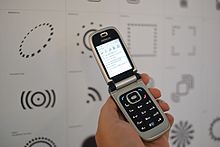The Human–computer interaction portal

Human–computer interaction (HCI) is research in the design and the use of computer technology, which focuses on the interfaces between people (users) and computers. HCI researchers observe the ways humans interact with computers and design technologies that allow humans to interact with computers in novel ways. A device that allows interaction between human being and a computer is known as a "Human-computer Interface (HCI)".
As a field of research, human–computer interaction is situated at the intersection of computer science, behavioral sciences, design, media studies, and several other fields of study. The term was popularized by Stuart K. Card, Allen Newell, and Thomas P. Moran in their 1983 book, The Psychology of Human–Computer Interaction. The first known use was in 1975 by Carlisle. The term is intended to convey that, unlike other tools with specific and limited uses, computers have many uses which often involve an open-ended dialogue between the user and the computer. The notion of dialogue likens human–computer interaction to human-to-human interaction: an analogy that is crucial to theoretical considerations in the field. (Full article...)
Selected article -

Mobile interaction is the study of interaction between mobile users and computers. Mobile interaction is an aspect of human–computer interaction that emerged when computers became small enough to enable mobile usage, around the 1990s.
Mobile devices are a pervasive part of people's everyday lives. People use mobile phones, PDAs, and portable media players almost everywhere. These devices are the first truly pervasive interaction devices that are currently used for a huge variety of services and applications. Mobile devices affect the way people interact, share, and communicate with others. They are growing in diversity and complexity, featuring new interaction paradigms, modalities, shapes, and purposes (e.g., e-readers, portable media players, handheld game consoles). The strong differentiating factors that characterize mobile devices from traditional personal computing (e.g., desktop computers), are their ubiquitous use, usual small size, and mixed interaction modalities. (Full article...)WikiProject
Need help?
Do you have a question about Human–computer interaction that you can't find the answer to?
Consider asking it at the Wikipedia reference desk.
General images
Related portals
Subcategories
Subtopics
- Usability
- Design
- User Experience
- Technology
- Psychology
- Concepts and Theory
Associated Wikimedia
The following Wikimedia Foundation sister projects provide more on this subject:
-
Commons
Free media repository -
Wikibooks
Free textbooks and manuals -
Wikidata
Free knowledge base -
Wikinews
Free-content news -
Wikiquote
Collection of quotations -
Wikisource
Free-content library -
Wikiversity
Free learning tools -
Wiktionary
Dictionary and thesaurus












































